Pump Handbook by Igor J. Karassik, Joseph P. Messina, Paul Cooper, Charles C. Heald - 3rd edition
Подождите немного. Документ загружается.

3.8 VANE, GEAR, AND LOBE PUMPS 3.125
A number of other auxiliary devices and arrangements can be found in vane, gear, and
lobe pumps, but two are especially characteristic of these pump types. Given the positive
displacing nature of these pumps, and the potentially high pressures that can result at the
outlet of the pump if there is an obstruction or blockage, safety relief valves must be used
with all positive displacement pumps. They limit the pressure by opening an auxiliary
passage at a predetermined set pressure and relieving flow back to the inlet side of the
pump or to the fluid’s original source. They can be installed externally or serve as an inte-
gral part of the pump. One exception is flexible member pumps, which, by the nature of
their design, usually do not require one, due to the resiliency and expandability of their
elastomeric components.
Nonetheless, most rotary pumps are available with integral relief valves. Although
these devices are a necessary investment for safety, they are not a substitute for an exter-
nal system relief valve.They are a secondary safety device at best and are not intended for
continuous duty, flow control, or system pressure modulation.
To reduce fluid viscosity in the pump body to facilitate a successful startup and main-
tain event-free operation, heating jackets are used. They can be either integral to the pump
(either welded on or part of the body casting) or a separate bolt-on type.They are common
with asphalt, gelatins, paraffin, molasses, greases, and similar fluids where, without heat-
ing, the power and torque required to drive the pump could easily overload the driver. If
viscous enough, a cold startup could actually destroy the mechanical seal, shear a shaft
coupling, break a drive shaft, or cause damage to the equipment some other way. Heating
jackets are not intended to be the main source of heating in the system. If the system
requires the fluid to be heated, some other means, such as heat tracing the system piping,
must be used.
Materials of Construction When selecting materials for rotary pumps, consideration
must be given to the following material properties:
• The modulus of elasticity (for deformation purposes)
• The coefficient of thermal expansion (for varying temperatures)
• The coefficient of friction (for resistance to galling when in sliding contact)
For rotary pumps with flexible members, further consideration must be given to the
materials’ bulk modulus for recovery from deformation.
The close running clearances of rotary pumps require that their materials resist defor-
mation and deflection by the various forces present when the pump is operating. If they do
not, then such deformation or deflection could open the clearances and lower the operat-
ing efficiency dramatically or close the clearances and cause high mechanical loading and
seizing between the moving and stationary parts.
The materials must also have compatible coefficients of thermal expansion. With the
potential for deflection of the rotating parts always present, the materials selected must
also have good bearing characteristics to resist galling up to the point of a compressive
yield of the mating materials. This is especially important when pumping low-lubricity
fluids.
Furthermore, materials used for corrosion resistance in non-contacting surfaces of cen-
trifugal pumps may be unusable in rotary pumps where the continuous sliding contact
between parts can wear away their passivating or protective layers. In general, rotary
material restrictions become more severe when handling low-viscosity fluids at higher
pressures and/or low lubricity fluids with abrasives. In addition, even where there is no
load-bearing contact between the rotating and stationary parts under normal conditions,
the high transient forces generated at startup, shutdown, or any other unusual operating
conditions (such as cavitation) must be considered when selecting pump materials.
The performance of flexible member pumps heavily depends on the material of the flex-
ible member. Its bulk modulus must be high enough to keep distortion under pressure
within functional limits and it must be resilient enough to spring back to its original shape
after flexing or compressing. For instance, if, once deflected, the vanes in a flexible vane
pump stayed that way, the pump could no longer operate. That is, these materials must be
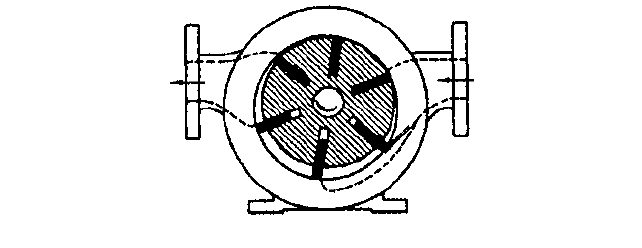
3.126 CHAPTER THREE
FIGURE 2 A typical external vane pump
chosen not only to satisfy the desired hydraulic conditions, but also for resistance to dete-
rioration from fatigue, chemicals, and the temperatures to which they may be exposed.
Vane Pumps Two basic types of vane pumps exist. The most common is the rigid slid-
ing metal vane type, and the other is the flexible or elastomeric vane used for dirty or
chemically aggressive fluids. Both are based around external sliding vanes rotating about
a non-concentric cam.
All rigid vane pumps have moveable sealing elements in the form of non-flexing blades,
rollers, buckets, scoops, and so on. These elements move radially inward and outward by
cam surfaces to maintain a fluid seal between the OTI and OTO sectors during pump
operation. When the cam surface is internal to the pump body and the vanes are mounted
in or on the rotor, the pump is called an internal vane pump.The OTI volume is defined by
the body walls, the rotor walls, the fluid seal contact between the vanes, and the body. The
body wall surface, the rotor surfaces, and the vane-to-rotor and vane-to-body fluid seal
points define the CTIO volume.The body surface, the rotor surface, the vane-to-body fluid
seal points, and the vane-to-rotor fluid seal points define the OTO volume.
In internal vane pumps, the volume behind the vanes must always be either a com-
posite constant volume or else be vented, because of the piston-like pumping action of the
vanes on the fluids trapped there. However, no such venting is required when the vanes
are in the form of rocking slippers.
When the cam surface is external to the radial surface of the rotor and the vane, or the
vanes are mounted in the body or stator, the pump is called an external vane pump and is
illustrated in Figure 2. The OTI, CTIO, and OTO volumes are defined the same as for
internal vane pumps when multiple external vanes are used. In this case, the rotor sur-
face, the body surface, and the fluid seal points between them define the CTIO volume.
In addition to rigid, sliding metal vane pumps, flexible or elastomeric vane type pumps
also exist. This kind of pump, illustrated in Figure 3, has a pumping action similar to that
of an internal vane pump with the OTI, CTIO, and OTO volumes defined by the rotor sur-
faces, the body surfaces, the fluid seal contacts between the rotor flexible vanes, and the
body surfaces.
The flexible liner pump in Figure 4 is similar in pumping action to the external vane
pump, and all three chamber volumes of it are defined by the inner surface of the body, the
outer surface of the liner, and the liquid seal contact between the liner and body bore. Most
flexible liner pumps, unlike other rotary pumps, have at least one position of the rotor in
which no fluid seal exists between the OTI and OTO volumes. The pump depends only on
fluid velocity and inertia to limit backflow during this phase of rotation.
Vane pumps offer flows at up to 1,000 gpm (3,785 l/min) and pressures at up to 125
lb/in
2
(8.6 bar). They are commonly used for low-pressure transfers of gasoline, kerosene,
and similar light hydrocarbons.
Gear Pumps Evidenced by drawings dating back to the 16th century, the gear pump is
one of the oldest pumps of any type. It is also the most common of all rotary pumps due
to the wide variety of applications it can be used in.
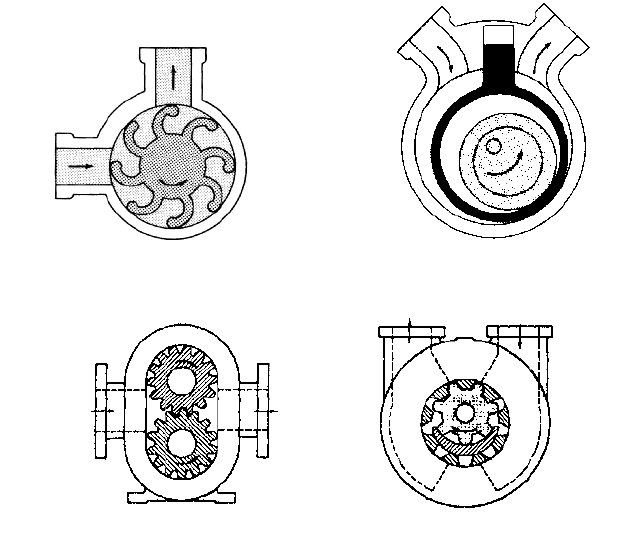
3.8 VANE, GEAR, AND LOBE PUMPS 3.127
FIGURE 3 Flexible vane pump
FIGURE 4 Flexible liner pump
FIGURE 5 A typical external (left) and internal (right) gear pump
Gear pumps have two gears that mesh to provide its pumping action, with one gear dri-
ving the other. The physical contact between the gears forms a part of the moving fluid seal
between the inlet and outlet ports.The outer radial tips of the gears and the sides of the gears
form part of the moving fluid seal between the inlet and outlet ports. The gear contact locus
moves along the tooth surfaces and jumps discontinuously from tooth to tooth as the gears
mesh and unmesh during rotation. These two characteristics distinguish gear pumps from
lobe pumps where the rotors (lobes) are incapable of driving each other and the fluid seal con-
tact locus between lobes moves continuously across all the radial surfaces of the lobes.
Gear pumps are classified as external or internal (see Figure 5), and external gear
pumps can be either timed or untimed. External gear pumps have their gear teeth cut on
their external or outside diameter and mesh about their outside diameters. Bearings sup-
port the shafts at both ends with the gears located between the bearings.This resists shaft
deflection and contact between the gears and casing wall, enabling the pump to operate at
higher pressures and with less overall wear over time than would otherwise be possible.
Internal gear pumps, on the other hand, have one larger gear (rotor) with gear teeth
cut internally on the major diameter meshing with and driving a smaller externally cut
gear (idler). Pumps of this type can be with or without a crescent-shaped partition to
define the OIT, CTIO, and OTO zones.
The OTI volume of the pump chamber in gear pumps is defined by the body walls and
by where each tooth tip meets and seals with the body walls as it leaves the OTI volume.
The fluid trapped between the gear teeth and the body walls is sealed from both inlet and
outlet chambers and is the CTIO volume. The OTO volume is defined by the body walls
and the gear tooth surfaces between the fluid seal points where each tooth tip leaves the
body wall and enters the OTO volume and fluid seal points where the gears mesh.
A part or all of the side (or axial) surfaces of the gears run in small-clearance contact
with the axial end faces of the pumping chamber. The gear teeth run in small-clearance
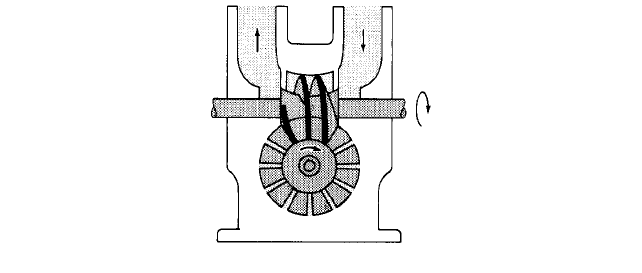
3.128 CHAPTER THREE
FIGURE 6 A typical screw-and-wheel pump
contact with each other where they mesh.The tips run in small-clearance contact with the
radial surfaces of the pumping chambers in their travel from the OTI to OTO volume.
Load-bearing contact between the rotors or between the rotors and the stator may exist in
all three of these zones, and the apertures defined by the running clearances in these
zones determine the amount of slip between the OTO and OTI volumes for any given pres-
sure difference and viscosity between them.
Both gears share pumping torque, and the proportional amount of the total torque
experienced by each gear at any instant is determined by the locus of the fluid seal point
between the gear teeth. As this fluid seal point moves toward the center of gear rotation,
the pumping torque on that gear increases, and as the seal point moves away from the cen-
ter, the torque decreases. When external timing gears are used, they transfer torque from
one rotating assembly to another to safeguard against accelerated wear when dry running
or handling low-lubricity or abrasive fluids.
A special form of gear pump illustrated in Figure 6 is known as a screw-and-wheel
pump. The driving gear is helical, and the driven gear is a special form of a spur gear. The
helical gear always is the driving, or power, rotor in this type of pump, and external tim-
ing gears are not used. The pumping torque in the screw-and-wheel pump is felt both by
the screw and by the wheel, and the amount of torque felt by each is determined by the
fluid seal contact locus points between the two rotors.As in other gear pumps, the running
clearances between the rotors and between the rotors and the body walls determine leak-
age from the OTO volume to the OTI volume.
External gear pumps are capable of flows up to 1,500 gpm (5,680 l/min), pressures up
to 500 lb/in
2
(34.5 bar), and viscosities up to 1,000,000 SSU (216,000 centistokes). They are
found in both clean and dirty services serving the original equipment manufacturer
(OEM), refinery, tank farm, marine, and API-related industries. Internal gear pumps are
capable of flows up to 1,100 gpm (4,165 l/min), pressures up to 225 lb/in
2
(15.5 bar), and
viscosities up to 1,000,000 SSU (216,000 centistokes). They are typically used for lower
pressure transfers of fuel oils, paints, and various chemicals in the chemical processing
and OEM industries.
Lobe Pumps The lobe pump receives its name from the rounded shape of the rotor
radial surfaces that permits the rotors to be continuously in contact with each other as
they rotate. Lobe pumps can be either single- or multiple-lobe pumps and carry fluid
between their rotor lobes much in the same way a gear pump does.
Unlike gear pumps, however, neither the number of lobes nor their shape permits one
rotor to drive the other, and so all true lobe pumps require timing gears. The body surfaces,
rotor surfaces, the contact between rotors, and the contact between rotor lobe ends and the
pump body define the OTI volume of a pump. The contact between the lobe ends and the
body wall and the adjoining body wall and lobe surfaces define the CTIO volume.The body
walls, rotor surfaces, lobe-to-body wall contacts, and the lobe-to-lobe contacts define the
OTO volume.
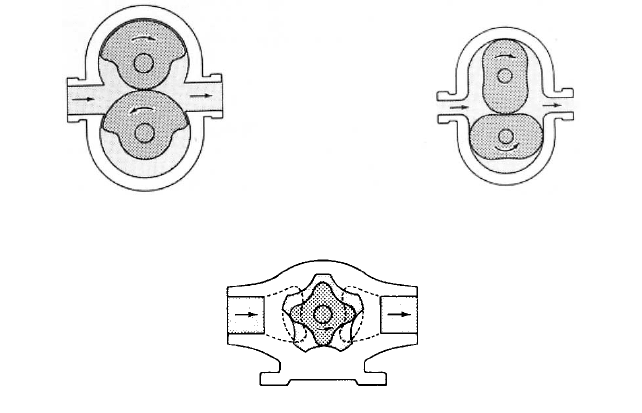
3.8 VANE, GEAR, AND LOBE PUMPS 3.129
FIGURE 7 Typical single-lobe (left) and multiple-lobe (right) pumps
FIGURE 8 A typical internal gear, or internal lobe, pump
In the two-rotor lobe pumps shown in Figure 7, the torque is shared by both rotors with
the proportional amount of torque dependent on the position of the rotor-to-rotor contact
point on the rotor contact locus.When the contact point is at the major locus radius (max-
imum lobe radius of one rotor in contact with the minimum lobe radius of an adjoining
rotor), one rotor sees the full pumping torque, while the other rotor feels a balanced torque.
The transfer of a full pumping torque from one rotor to the other takes place as many
times in each complete revolution of a rotor as there are lobes on the rotor.
An internal lobe, or gerotor pump, is shown in Figure 8 and has a single rotor with a
lobe-like peripheral shape. It moves in a combination of rotations and gyrations about its
center of rotation in a body with internal, lobe-shaped contours in such a way that the rotor
always touches the body at two or more locations to preserve the fluid seal between OTI
and OTO volumes. The outer rotor surface, inner body surface, and the fluid seal points
between them define the OTI volume. The outer rotor surface and the inner body surface
between two adjacent fluid seal points define the CTIO volume. The outer rotor surface,
inner body surface, and the rotor-to-body fluid sealing points define the OTO volume.
Most pumps of this type have one fewer rotor lobe than an internal body lobe cavity
and the term progressing tooth gear pump is sometimes used. The full pumping torque is
seen by the single rotor, but the torque is cyclic. It is a function of the position of the rotor
and its sealing arrangement with the pump body, while the number of torque cycles per
rotor revolution is equal to the number of lobes on the rotor.
Lobe pumps are capable of flows up to about 1,000 gpm (3,785 l/min) and pressures up
to 125 lb/in
2
(8.6 bar). They are commonly used to pump sludge in wastewater treatment
plants and in stainless steel systems for handling foodstuffs in the food, beverage, dairy,
and pharmaceutical industries.
A summary of the main application advantages of vane, gear, and lobe pumps is shown
in Table 1.
COMPARISONS TO CENTRIFUGAL PUMPS _______________________________
A rotary pump uses mechanical and hydraulic forces to create a flow against a system
backpressure. Centrifugal pumps, on the other hand, create pressure by imparting a veloc-
ity to the fluid and converting the velocity energy to a pressure energy as the fluid flows
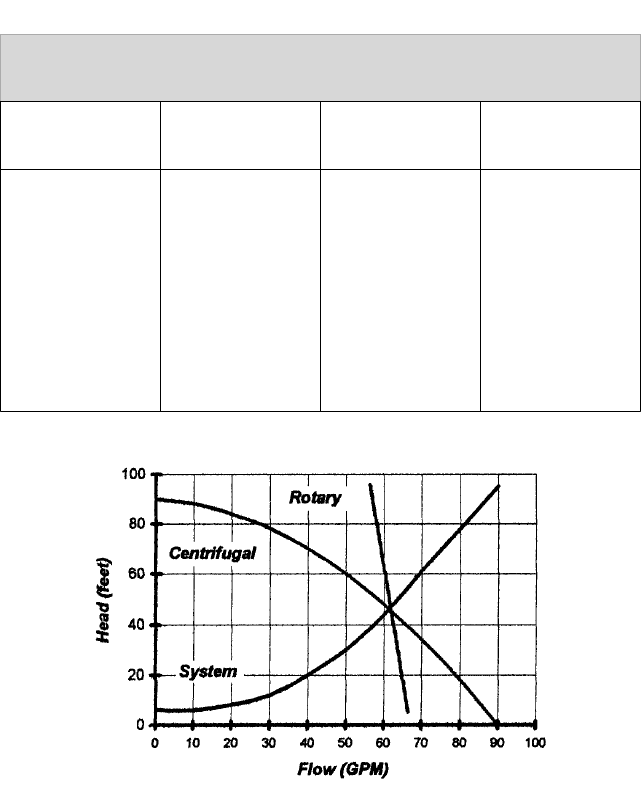
FIGURE 9 Typical performance curves (m = ft 0.3048; m
3
/h = gpm/4.403)
Application Advantages
Vane
Gear (External)
Gear (Internal)
Lobe
• Can handle
viscosities under
32 SSU
• Self compensating
for wear
• Available in a
variety of
materials
•
Inexpensive
•
Can handle high
viscosities
• High flows and
pressures
•
Between-the-
bearing design
prolongs life.
•
Quiet running
•
Integral relief valve
available
•
Can handle high
viscosities
•
Available in a
wide variety of
materials
•
Simple,
inexpensive design
•
Integral relief valve
available
•
Can handle high
viscosities
•
Low shear pumping
•
Available in
a variety of
materials
•
Can run dry if seals
are flushed (due to
timing gears)
TABLE 1 Summary of vane, gear and lobe pump attributes
3.130
CHAPTER THREE
around the casing and out the discharge nozzle.A comparison of the resulting performance
of these two different pump types is shown in Figure 9.
The conditions of service will usually determine the best pump for an application. For
instance, for constant pressure at varying flow rates, a centrifugal pump would be a good
choice.An example of this is a municipal water system where consistent pressure must be
maintained over a wide range in usage levels. By contrast, for a constant flow in the pres-
ence of varying back pressures, a rotary pump would be better. An example of this is an oil
pipeline, where system economics dictate constant flow rates, regardless of any system
pressure variations from changes in viscosity or pipe diameter.
Other differences exist between centrifugal and rotary pumps as well. The perfor-
mance curves, affinity laws, and terminology used to describe rotary pumps are all differ-
ent. And since rotary pumps are primarily for viscous fluids, the applications and markets
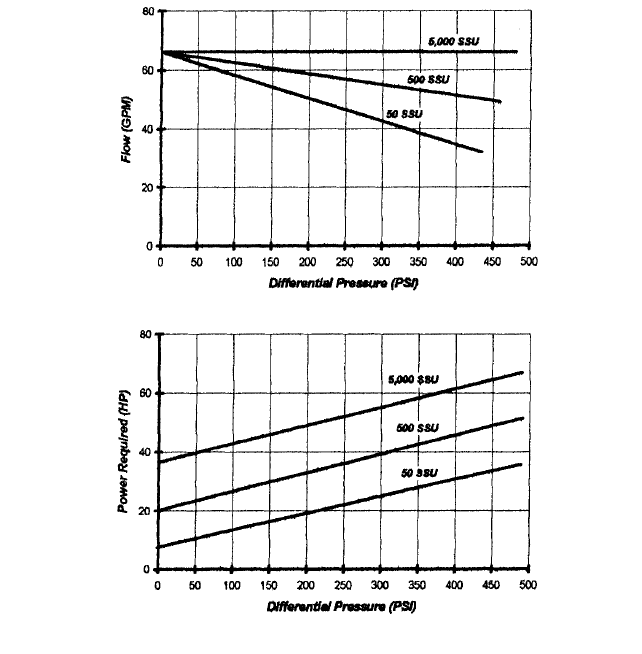
3.8 VANE, GEAR, AND LOBE PUMPS 3.131
FIGURE 10 Typical rotary pump flow and power curves (bar = psi/14.5; kW = hp 0.746; 50, 500, 5000 SSU = 7,
108, and 1080 centistokes respectively.)
served by these two pumps are also different. One of the few direct comparisons that can
be made between centrifugal and rotary pumps is with single- versus multi-stage pumps.
Even here though, the analogy is not a perfect one, and certain rotary pumps, such as pro-
gressing cavity pumps, fit the description better than others. Other factors, such as verti-
cal versus horizontal mounting, metal versus non-metallic materials, sealless and
magnetically driven versus dual-containment mechanical seals and conventional drivers,
are similar whether considering a centrifugal or rotary pump.
Rotary Pump Curves Centrifugal pump curves plot the flow on the X-axis with the dis-
charge head on the Y-axis. However, rotary pumps develop the flow against a system back-
pressure, rather than developing head with a corresponding flow rate. Their performance
curves therefore show the flow on the Y-axis with differential pressure along the X-axis,
as shown in Figure 10.
The influence of differential pressure on the flow is greatest with lower viscosity. Since
this represents the worst (least) case for flow, it is the point around which the flow rate is
established. Conversely, the maximum viscosity represents the worst (most) case from a
power standpoint and is therefore the point around which the driver is sized.
Other considerations, such as flat versus steep curves or matching a system curve to a
pump curve, also cannot be applied to rotary pumps the way they can with a centrifugal
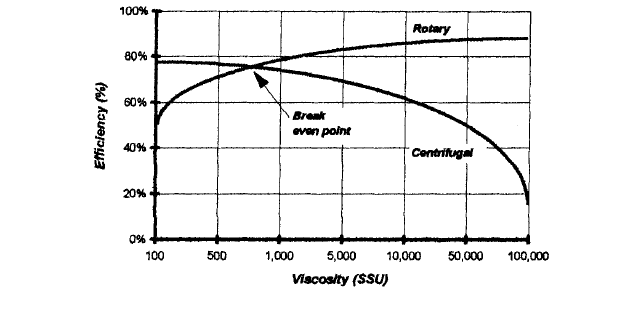
3.132 CHAPTER THREE
FIGURE 11 Typical efficiences as a function of viscosity. (In this range, centistokes SSU/5.)
pump. Instead, a rotary pump is selected for a given differential pressure and viscosity at
the nearest commercially acceptable speed. For viscosities under 3,000 SSU (650 centis-
tokes), this means at synchronous motor speeds with the flow rate falling at the design
point or (ideally) slightly above it. For higher viscosities, rotary pumps will be run at
reduced speeds, which in some cases can go well below 100 revolutions per minute (rpm).
Performance with Viscous Fluids Centrifugal pumps assume the absence of any
appreciable viscous drag across the impeller shroud and vane surfaces when developing
their pumping action. However, viscous drag, as the fluid passes across these surfaces, can
be considerable with higher viscosities.With an increasing viscosity, an increasing amount
of energy must be expended to overcome these forces and produce the same amount of
hydraulic work. At some point, viscosity will simply overtake the centrifugal pump, and
it can no longer overcome the inertia and viscous drag losses of the fluid. The effect of this
can be seen in Figure 11.
Since rotary pumps do not work this way, they are better suited for high-viscosity flu-
ids. Certain rotary pumps, such as twin screw pumps, can even go as high as 1,000,000
SSU (216,000 centistokes) without a significant deterioration of performance or efficiency.
Compared to centrifugal pumps, rotary pumps are less efficient at lower viscosities but
more efficient at higher viscosities. From an applications standpoint, this crossover point
will vary from pump to pump and depends on many factors, but as a rule of thumb, it usu-
ally falls between 500 and 1,000 SSU (108 and 216 centistokes).
Affinity Laws Rotary pumps do not have a single best efficiency point (BEP) the way a
centrifugal pump does, and no parallels for radial thrust loads exist as a function of the
position on the curve relative to BEP the way there is with centrifugal pumps. Similarly,
no rotary pump parameter is analogous to the specific speed (N
S
) of centrifugal pumps;
although, an approximate N
S
-domain into which rotary pumps fall can be identified (see
Chapter 1 and Section 2.1). Instead, rotary pumps simply use the flow per revolution to
make general comparisons. A summary of the basic rotary pump affinity laws in shown
in Table 2.
SYSTEM CONSIDERATIONS ___________________________________________
The variety of applications and system conditions, including the vast number of fluids
handled in rotary pump applications, precludes a comprehensive coverage in a handbook
of this type. The best source for this information is the manufacturer of that particular
pump type.
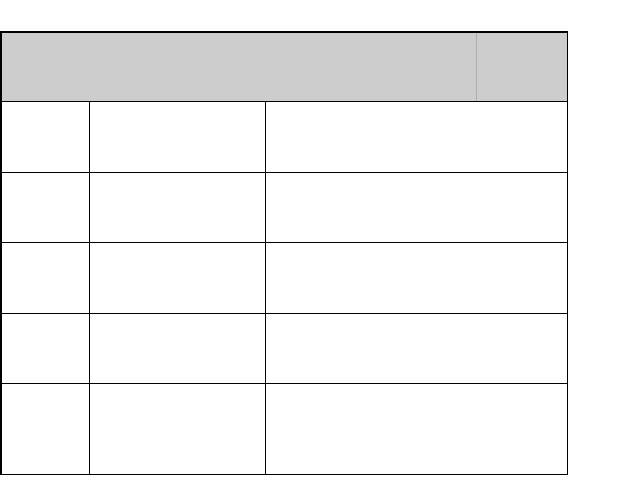
3.8 VANE, GEAR, AND LOBE PUMPS 3.133
TABLE 2 The basic affinity laws for rotary pumps
Rotary Pump Affinity Laws For Speed
Speed Change
Corresponding Effect
{RPM
2
/ RPM
1
}
{GPM
2
/ GPM
1
}
{RPM
2
/ RPM
1
}
no direct effect on differential pressure
{RPM
2
/ RPM
1
}
{BHP
2
/ BHP
1
}
{RPM
2
/ RPM
1
}
{NPSH
2
/ NPSH
1
}
X
where
X
varies
from 1.5 to 2.5
Mechanical Installation All rotary pumps, particularly rigid rotor pumps, must be
installed so no mechanical forces other than those imposed by pump-generated pressures
can act to warp or distort the pump chamber or rotating assembly. This is important
because relatively small distortions of a few thousandths of an inch can cause interference
between rotating and stationary parts and generate high wear rates or pump damage.
To avoid such distortions, the pump must not be installed with overly long, rigid fit-
tings or in such a way that the pump body supports the weight of the piping system. The
problem of distortion of clearances in the pump chamber is not as severe for flexible mem-
ber pumps, but large mechanical forces that distort the pump body may also cause distor-
tions of the mechanical seals and accelerate wear of the bearings. A cardinal rule, then, is
that a rotary pump must not be rigidly coupled to the piping system in a way that causes
it to support the weight of the piping or otherwise exposes it to any forces from thermal
expansion. Poor mechanical installation is the cause of many field problems.
Dry Running Most rotary pumps will be damaged if allowed to run dry. As long as the
system provides a positive static pressure on fluid present at the inlet, the pump should
prime and not run dry. If a negative inlet gage pressure, or suction lift, is present at the
pump inlet, the installation should be checked to ensure airtight seals throughout the
entire upstream piping.
The sealing arrangement on the pump must also be checked for any leakage of air or
gas into the pump through the seal. If these conditions are satisfied, fluid will enter the
pump soon after pump operation starts because of the vacuum generated by pump opera-
tion. If these conditions are not met, air or other gases will flow through leaks in the inlet
system or seal to satisfy the pump flow rate requirements and the pump will run dry. One
safeguard to ensure fluid at the pump inlet is to install a foot valve in the submerged por-
tion of the inlet piping. Once primed, the foot valve will keep fluid in the pump and pre-
vent it from running dry upon subsequent restarting.

3.134 CHAPTER THREE
Suction Strainers Like most other pumps, rotary pumps last longer when handling
clean fluids. Nonetheless, this is an ideal scenario, and the pump will more realistically
encounter dirty or abrasive-laden fluids of varying degrees. Fine particles and abrasives
will cause wear in the close clearances of the pump, which eventually reduces pump flow
rate by increasing the slip through the increased clearances.
As such, all rotary pumps should have a suction strainer to exclude larger materials
such as welding slag, scale, rust, chips, rags, bolts, nuts, and so on. Since a suction strainer
contributes to suction line losses, this reduces the net inlet pressure available. The finer
the filtration, the greater the restriction and the more frequently it must be maintained.
This leads to a trade-off between the cost of the added maintenance versus the cost of
replacing the worn pump parts earlier than they would be otherwise.
When pumping fluids over 5,000 SSU (1080 centistokes), the finest strainer screen
practical is a -inch (1.5 mm) perforation. Strainers and filters not only require periodic
maintenance, but should also be instrumented accordingly. It is important for the user to
provide some means of monitoring, such as a differential pressure gauge or switch, since
a clogged strainer will cause the pump to cavitate or even run dry.
Entrained Air and Dissolved Gases An important consideration with rotary pumps
is the amount of entrained air or gas in the fluid. It is generally neglected, since a rotary
pump cannot become vapor-bound the way a centrifugal pump can. Nonetheless, with
entrained air present, there can be a perceived loss in the outlet flow. If the entrained air
is a large enough percentage, there may be unacceptable noise and vibration levels as well.
For example, if a fluid contains five percent entrained gas by volume and the suction
pressure is atmospheric, the mixture is 95 percent liquid and 5 percent gas. This mixture
fills up the moving voids on the inlet side, with 5 percent of the space filled with gas and
the remainder with liquid. Therefore, in terms of the amount of liquid handled, the output
is reduced directly by the amount of gas present, or 5 percent. Unless this is understood
up front, it could lead to a less than satisfactory output flow rate through no direct fault
of the pump itself.
Entrained air is common in systems where the liquid is cycled frequently. In many
cases, the foaming or air entrainment cannot be avoided, such as with the lubrication sys-
tem on a large reduction gearbox. Instead, the condition must be known and well under-
stood before selecting a pump for the application.
If dissolved gases (gases different than the fluid’s own vapor) are present in the fluid,
the effect on the output flow is the same as with entrained gases.This is because the dis-
solved gases will come out of solution when the pressure is lowered, just as the fluid’s own
vapor will. This will have the same net effect as the entrained gas and will occupy the
available displacement capacity. Although the fluid mass transfer rate will not be
affected, this is likely to be small comfort since the measured liquid displacement will be
reduced.
Noise Pumps are often the most offensive noise sources in hydraulic machinery. High-
pressure pulsations and heavily loaded sliding elements within the pump produce broad-
band, high-energy airborne noise. Vane, gear, and lobe pumps, however, are among the
lowest noise producers of any fixed displacement-type pump. Flow is delivered continu-
ously without the variations that produce noise in conventional hydraulic pumps. Pump-
ing elements utilize a fluid film, reducing the sliding contact, and the visco-elastic
properties of the fluids they pump help dampen whatever fluid-borne pressure pulsations
are present. These design features are responsible for the wide use of these pumps wher-
ever noise is critical. For instance, they are widely installed on die-casting machines, plas-
tics equipment, presses, and an enormous variety of machine drives and machine tools.
Inlet Pressure The absolute pressure above the vapor pressure available at the pump
inlet must always exceed the absolute pressure above the vapor pressure required by the
pump. For rotary pumps, this pressure is determined by Hydraulic Institute standards
similar to those used for centrifugal pumps.
Another consideration is the effect of a net negative total differential pressure.This can
occur when there is a variable positive static pressure on the inlet that exceeds the dis-
charge or outlet pressure. In this case, the flow slip reverses direction and actually adds
1
16
